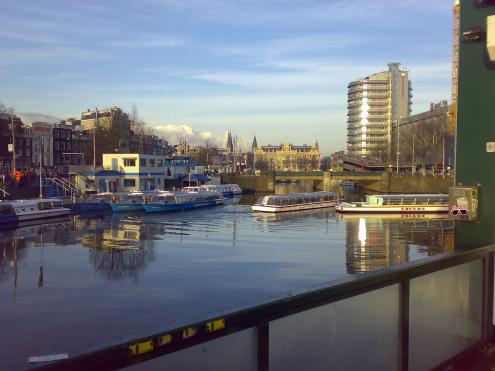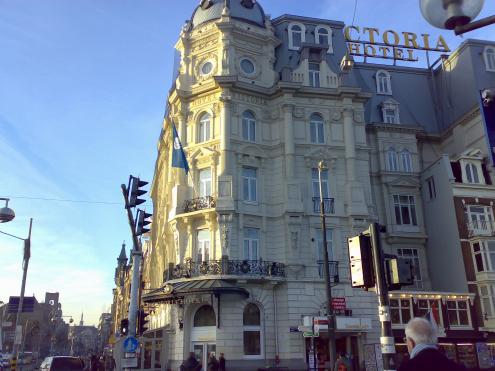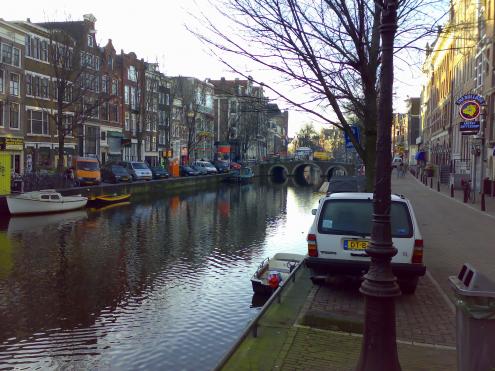By David Ponce
When it comes to taking quality pictures, it’s undeniable that cellphones are making significant strides forward. Hell, only two years ago, VGA was considered hot. But even with high megapixel counts, cameraphone images are still not up to par with even a basic point-and-shoot.
Until now.
The Nokia N73 features a 3.2MP camera with Carl-Zeiss optics, but most importantly: auto-focus and a mechanical shutter. These two features allow the phone to take pictures that are nearly indistinguishable from those taken from low-end dedicated digital cameras… as long as there is enough light. Of course, taking pictures is not all the phone does right, and I’ve got a good bit of ground to cover, so lets get started. Out here I’ll say this much: great phone, gorgeous pictures, slightly long camera startup times. But… no WiFi!
Keep reading for a bunch of unboxing pictures, and the full review.
The Hardware
The phone is much smaller than many of Nokia’s N-Series phones. It’s light (116 g) and feels comfortable in the hand. The camera is protected by a spring assisted slide-out cover that feels a lot sturdier than its predecessor’s, the N70 (see our review here). It doesn’t add any bulk to the device and sliding it open activates the camera function. There is also a secondary camera in front of the device, which would allow video calls should your network support this. Finally, there’s a strong LED flash
The showstopper, aside from the great pictures, is the screen. It’s a large 2.4 inch QVGA (240 x 320 pixels) TFT color display with up to 262,144 colors that does a terrific job of displaying images. As a matter of fact, this is perhaps also one of the downsides: the high contrast of the N73’s display will make your photographs look slightly better on the phone, than on your home computer. This may lead to some disappointment, but only due to raised expectations rather than to poor image quality.
There are two speakers, protected by a perforated grille that actually adds an elegant touch to the overall aesthetics of the phone. The dual speaker setup also allows for stereo sound. Of course, with the speakers being so close to each other, the stereo effect is marginal… but not imaginary. Ringtones can be configured to sound with a “3D effect”, and yes, you can actually hear the difference. The speakers are very loud and the phone can easily be used as a small boombox of sorts, perfect for sharing your music with friends, or annoying the coworkers in the cubicle next to yours.
There is a dedicated shutter button that functions just like those in regular cameras: pressed halfway to focus, and fully to capture. There’s also a zoom button to take advantage of the camera’s 20X digital zoom.
To make room for the gigantic screen, the keypad had to be kept small. Unfortunately, I have to say that it’s a little uncomfortable to dial with, as the keys are nearly flush against one another and it’s fairly easy to press the wrong button. Big meaty thumbs will almost certainly have a hard time trying to get the numbers right.
There is room for memory expansion via MiniSD with support up to 2GB, though I’m not sure about 4GB support. From doing some research online, it appears not to work. The expansion slot is protected by a cover that’s nearly impossible to remove without sharp nails or some other sharp or pointy instrument, which turned out to be quite frustrating.
Battery life is excellent, lasting for up to ten days in pure standby mode, and needing a charge every three to four days with regular use.
In general, the phone feels well constructed. It’s of a good size, good looks and top-notch quality.
The Software
The phone runs on Symbian ver. 9.1, and the user interface is Nokia S60 3rd Edition. It’s a powerful base on which a nearly endless stream of third-party applications can run. And I have to say, everything runs very, very smoothly. The phone is snappy and going from one application to another is quick. It doesn’t hang, never froze on me and everything that needed to work, did.
You’ve got a wide range of PIM applications, as well as PC synchronization with Outlook and Lotus Notes and Organizer. There’s even an email client with attachments and mobile VPN support.
The most important “feature” however, is the phone’s internet browser. It’s based on Safari, and works brilliantly. Pages are automatically formatted for mobile viewing, and scrolling around is a breeze. If you try to go from one distant point on a page to another, the browser pops up a transparent thumbnail of the page with a red rectangle indicating the current viewing area. You can then easily select where you want to go.
If you press “back”, a beautifully rendered, transparent series of thumbnails of the pages you last visited appears. You can then scroll the thumbnails to select the exact page you want to go back to. It’s quick and efficient, and makes surfing the internet on a tiny screen almost enjoyable.
Aside from this, you’ve got multimedia applications which are able to run a variety of formats. The music browser is the same as the N91’s, so navigating through your music collection is easy; it’s roughly the same organization scheme as the iPod.
Connectivity is done via Pop-Port interface with USB 2.0 full speed, Bluetooth 2.0 and IR. But get this: no WiFi! For certain people, like me, with data plans that cost about as much as a small mortgage, it’s a killer. Had it not been for this omission, the phone would have been nearly perfect in this reviewer’s eyes.
The Camera
The centerpiece of the N73 is its 3.2MP (2048 x 1536 pixels) camera, of course, and I’m happy to say that Nokia’s outdone itself. Pictures taken under the right lighting conditions are flawless and could easily be printed and passed off as regular digicam pics, for sizes up to 8 X 10 inches.
And, there are tons of features and options. Just check out these specs:
? Integrated flash (operating range up to 1m)
? Modes: auto, off, on, red-eye reduction
? Advanced camera modes: still, sequence, video
? Scenes: automatic, user defined, close-up, portrait, landscape, sport and night
? White balance: automatic, daylight, cloudy, tungsten, fluorescent
? Color tone: normal, sepia, B&W, vivid, negative
? Light sensitivity: high, medium, low, automatic
? Settings for brightness adjustment, image quality, self-timer, white balance and color tones
As soon as the camera lens cover is pulled down, the camera is activated. It goes into landscape mode, which sort of forces you to hold the phone horizontally, much as you would a regular camera. When the shutter is pressed halfway, auto-focus kicks in. It usually takes about a second or two for the camera to focus, and then you can take your shot. Once taken, you can review your picture, delete it, add it to your print basket or just print it.
If there is a lot of light, everything turns out perfect. Images taken in good lighting conditions are hard to distinguish from dedicated digicam pictures. However, they do not appear as saturated as they do while previewing on the phone’s display.
In lower light settings, image quality deteriorates rather quickly. The shots are still very serviceable, but they are grainy and wouldn’t make excellent prints. The three images that follow were taken in Amsterdam, and show the kind of pictures it takes.
Startup time was disappointingly slow. Between sliding the cover to activate, focusing and pressing the shutter, a good five to six seconds elapses, making impromptu shots unlikely. Between-shot times are more respectable at two to three seconds.
Still, despite its flaws, the camera on the N73 is at the top of the line. The handset competes head to head against Sony’s K810i, and the images it produces are comparable, if not better.
Conclusion
Nokia’s N73 is a great phone that does everything it needs to do almost perfectly. It was built around its spectacular camera, and makes cellular photography actually attractive, rather than tolerable as it is on most other mobiles. Certainly, there are flaws, but of all the Nokia phones we’ve tested so far, this one has given us the most satisfaction and pleasure to use.
PROS
– Auto-focus and mechanical shutter
– 3.2 MP with Carl-Zeiss optics
– Large 2.4 inch QVGA screen
– Twin speakers for stereo effect
– PictBridge for PC-less image printing
– Excellent battery life
CONS
– No Wifi!
– Slow camera startup time
– High contrast on mobile screen produces deceptively better image than in reality
– Hard to access expansion slot






>>of course, with the speakers being so close to each other, the stereo effect is marginal
Not sure if you realise this, but the two grills on the top of the phone cover only one speaker. The second speaker is at the bottom of the phone, giving the maximum spatial seperation possible on a phone. OK, stereo effect is still a bit poor, but… 🙂
Make sure you are running the newest firmware release; initially I found the lag time in operations to be tedious, but the newest firmware makes everything quite a bit snappier…
On my n73, the two grills on the top of the phone cover are only one speaker too. When I listen to first, i dont hear anything from it, and when i listen second, i hear sound. I thought it was a defect, is it? please give me some information about this thing..
THX, PixelLTU
Thx very very much!
I bought the nokia N73 model a month before and i took nearly around 200 snaps videos in this short span…the image quality was brilliant initially but now its has some problem…
I bought the nokia N73 model a month before and i took nearly around 200 snaps videos in this short span…the image quality was brilliant initially but now its has some problem…